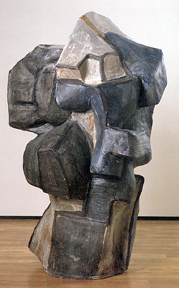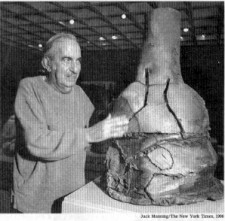
Peter Voulkos
American , 1924-2002
Sitting Bull, 1959
stoneware, wheel and paddled parts, slip and glaze
69 x 37 x 37 in.
SBMA, Bequest of Hans G.M. de Schulthess
1965.16

The ceramist Peter Voulkos, who reinvented his medium as a meeting ground for painting and sculpture, at the American Craft Museum.
COMMENTS
Peter Voulkos, an artist who elevated ceramics to new levels of abstraction and personal expression, as well as national prominence, died on Saturday in Bowling Green, Ohio. He was 78 and lived in Oakland, Calif. Ruth Braunstein, Mr. Voulkos's longtime dealer, said the cause was a heart attack. Few artists have changed a medium as markedly or as single-handedly as Mr. Voulkos, a large, muscular man with a charismatic personality and a voracious appetite for work, learning and experimentation. He emerged in the early 1950's, at a time when ceramics was searching out its roots in different craft traditions, especially Japanese, and when American painting and sculpture were expanding in all directions.
He made the most of both situations. Firmly grounded as a craftsman, Mr. Voulkos went on to reinvent ceramics as a meeting ground for painting and sculpture; he became, in essence, an Abstract Expressionist ceramist. During his 50-year career, Mr. Voulkos was influential as a thinker, teacher and fearless innovator who followed a constantly changing course. He incorporated techniques and tools from other disciplines - including commercial dough-mixing machines for the mixing of clay - and with Paul Soldner developed a prototype for the electric potter's wheel. Mr. Voulkos's work is represented in museum collections around the world. He established ceramics departments at the Los Angeles County Art Institute (now the Otis College of Art and Design) and the University of California at Berkeley that became magnets for younger potters. His demonstrations drew crowds; they could be flamboyant performances that often involved throwing pots whose size required him to stand on stools. His students, who were not always formally enrolled in his courses, included Mr. Soldner, John Mason, Ken Price, Billy Al Bengston, Ron Nagle, Stephen de Staebler and James Melchert.
In the early 1960s Mr. Voulkos also took on bronze, working in it nearly exclusively for several years and making large-scale abstract sculptures whose powerful compositions evoke those of David Smith and Anthony Caro. For his work in clay, he found influences throughout the history of ceramics, and also in Zen philosophy, his study of the Spanish guitar, the mysteries of the Egyptian pyramids and in cocaine, which landed him in a rehabilitation center.
Mr. Voulkos was born in Bozeman, Mont., in 1924, the third of five children of Greek immigrants. His father owned a small restaurant; his mother instilled the virtues of discipline and teamwork in her children. After high school he worked as a molder's apprentice, building molds for casting engine parts at a ship's foundry in Portland, Ore. In 1943 he was drafted into the Army Air Corps, serving as
an airplane armorer-gunner in the Pacific.
Mr. Voulkos first encountered clay in a required ceramics course at Montana State College in Bozeman, where he was studying painting and printmaking on the G.I. Bill in the late 1940's. Although he would continue to paint and later make monotypes and collages, he became an instant convert. When he quickly exhausted his clay allotment of 25 pounds a semester, he began digging up and refining his own, after locating a source from the clay on the tires of tanker trucks that pulled into the Burger Inn where he had a part- time job.
He quickly began winning prizes in important ceramics shows and was soon known on the national ceramics scene as a prodigious natural potter and a producer of elegantly thrown functional earthenware. His work was also admired for its exuberant brushwork decorations made with a wax-resist technique borrowed from printmaking. After earning an M.F.A. degree in ceramics from the California College of Arts and Crafts in Oakland, Mr. Voulkos returned to Bozeman and, with a classmate, Randy Autio, established a production pottery that sold dinnerware through high-quality stores. In the summer of 1953 he taught a course at the experimental, interdisciplinary Black Mountain College, near Asheville, N.C., at the invitation of the school's resident potters, Karen Karnes and David Weinrib. There he met men who were soon to be legends, including Robert Rauschenberg, John Cage, Merce Cunningham and Charles Olson. Afterward, he visited New York City, where he met Abstract Expressionist painters like Philip Guston, Willem de Kooning and Franz Kline.
The spontaneity and scale of New York School painting changed Mr. Voulkos's aesthetic. It sharpened his growing impatience with production pottery; he was already inspired by the ceramic work of artists like Picasso and Miro. It divided his career into parts as distinct as Bob Dylan's acoustic and electric periods, and just as controversial to his admirers. Its influence accelerated the following year when he was invited to establish a ceramics department at the Los Angeles County Art Institute.
He began pushing at the limits of his medium and later said that he threw out most of two years of work. Abandoning any semblance of utility, he moved toward progressively larger pieces, wrestling vessels and cylinders thrown from as much as 150 pounds of clay into stacked and cantilevered sculptures that might be five or six feet high. Decoration became aggressive violation - tearing, slashing and gouging - combined with brushwork that often recalled Kline's beamlike strokes.
Mr. Voulkos unveiled these works in a 1959 exhibition at the Landau Gallery in Los Angeles, shocking the ceramics world, although he was also acclaimed for bringing craft and art together. His new aesthetic hastened his departure from the Los Angeles school to Berkeley, which had been courting him. In the early 1960's he began experimenting with casting his ceramic pieces in bronze, and this led to his bronze sculptures.
His first marriage, to Margaret Cone ended in divorce. He is survived by his wife, Ann; their son, Aris, of Oakland; his daughter from his first marriage, Pier Voulkos of Oakland; a brother, John, of San Francisco; and two sisters, Mary Baptist, of Morgan Hill, Calif., and Margaret
Dull, of Athens, Ga.
He returned to clay in 1968, partly because his bronze pieces would not fit through the door of Ms. Braunstein's gallery. His ceramic art entered a new phase in 1979 when a young potter named Peter Callas built the first Japanese wood-burning kiln in this country (in Piermont, N.Y.) and persuaded him to try it. The extreme unpredictability of the process - in which temperatures could not be maintained evenly, and fire and ash frequently discolored the glazes - dovetailed with Mr. Voulkos's love of accident and spontaneity. The resulting works - large stacked pieces and plaquelike plates that he treated as paintings - were his roughest and most exuberant and, in the eyes of many, his best. In the last few years Mr. Voulkos started to cast his ceramic works in bronze again, working their surfaces with different patinas.
New York Times February 21, 2002
By ROBERTA SMITH
